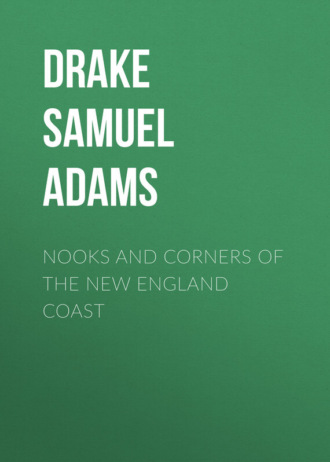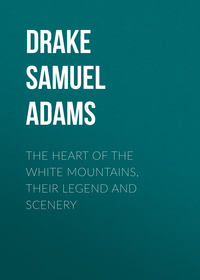 полная версия
полная версияNooks and Corners of the New England Coast
In the day when these coasts were stocked with beaver, its skin was the common currency of the country, as well of the Indians as of the whites. It was greatly prized in Europe, and constituted the wealth of the savages of northern New England, who were wholly unacquainted with wampum until it was introduced among them by the Plymouth trading-posts on the Penobscot and Kennebec.
The wigwam of a rich chief would be lined with beaver-skins, and, if he were very rich, his guests were seated on packs of it. Then, as now, a suitor was not the less acceptable if he came to his mistress with plenty of beaver. It was the Indians' practice to kill only two-thirds of the beaver each season, leaving a third for increase. The English hunters killed all they found, rapidly exterminating an animal which the Indian believed to be possessed of preternatural sagacity.
Our road, after crossing a northern spur of Sargent's Mountain, which lifts itself more than a thousand feet above the sea, led on over a succession of hills. Beyond Sargent's, Green Mountain stood unveiled, with what seemed the tiniest of cottages perched on its summit. Ere long Eagle Lake lay outstretched at the right, but it was in the trance of winter. The painter, Church, whose favorite ground lay about due south, christened the lake, doubtless with a palmful of water from its own baptismal font. The roadway is thrown across its outlet where the timbers of an old mill, that some time ago had gorged itself with the native forest, lay rotting and overthrown.
Green Mountain overpeers all the others. On its summit you are fifteen hundred and thirty-five feet higher than the sea. On this account it was selected as a landmark for the survey of the neighboring coasts. It is not difficult of ascent, as the mountain road built by the surveyors is considered practicable for carriages nearly or quite to the top. I had anticipated ascending it, but the new-fallen snow rendered walking difficult, and I was forced to content myself with viewing it from all sides of approach.
An acquaintance with the sierras of either half of the continent exercises a restraining influence in presence of an upheaval comparatively slight, yet it is only in a few favored instances that one may stand on the summits of very high mountains and look down upon the sea. New England, indeed, boasts greater elevations at some distance from her sea-coast, among which the Mount Desert peaks would appear dwarfed into respectable hills. On a clear day, and under conditions peculiarly favorable, a distant glimpse of Katahdin and of Mount Washington may be had from the crest of Green Mountain. In summer the little house is open for the refreshment of weary but adventurous pilgrims.
Here I would observe that the island nomenclature is painfully at variance with whatever is suggestive of felicitous rapport with its natural characteristics. The name of Mount Desert, it is true, is singularly appropriate; but then it was given by a Frenchman with an eye for truth in picturesqueness. In the year 1796, when the north half of the island was formed into a township, it was called, with sublimated irony, Eden. Green Mountain is not more green than its neighbors. At the Ovens I saw plenty of yeast, but not enough to leaven the name. Schooner Head is not more apposite.
Just before coming into Bar Harbor there is an excellent opportunity of observing the cluster of islands to which it owes existence. These are the Porcupine group, and beyond, across a broad bay, the Gouldsborough hills appeared in a Christmas garb of silvery whiteness. The Porcupine Islands, four in number, lie within easy reach of the shore, Bar Island, the nearest, being connected with the main-land at low ebb. On Bald Porcupine General Fremont has pitched his head-quarters. It was the sea that was fretful when I looked at the islands, though they bristled with erected pines and cedars.
The village at Bar Harbor is the sudden outgrowth of the necessities of a population that comes with the roses, and vanishes with the first frosts of autumn. It has neither form nor comeliness, though it is admirably situated for excursions to points on the eastern and southern shores of the island as far as Great Head and Otter Creek. A new hotel was building, notwithstanding the last season had not proved as remunerative as usual. I saw that pure water was brought to the harbor by a wooden aqueduct that crossed the valley on trestles, after the manner practiced in the California mining regions, and there called a flume. There is a beach, with good bathing on both sides of the landing, though the low temperature of the water in summer is hardly calculated for invalids.
From Bar Harbor, a road conducts by the shore, southerly, as far as Great Head, some five miles distant. After following this route for a long mile, as it seemed, it divides, the road to the right leading on five miles to Otter Creek, and thence to North-east Harbor, seven miles beyond. Excursions to Great Head, and to Newport Mountain and Otter Creek, should occupy separate days, as the shores are extremely interesting, and the scenery unsurpassed in the whole range of the island.
In pursuing his explorations at or near low-water mark, it will be best for the tourist to begin a ramble an hour before the tide has fully ebbed. The tides on this coast ordinarily rise and fall about twelve feet, and in winter, as I saw, frequently eighteen feet. Hence the advance and retreat of the waves is not only rapid, but leaves a broader margin uncovered than in Massachusetts Bay, where there is commonly not more than eight feet of rise and fall. In many places along the arc of the shore stretching between Bar Harbor and Great Head, the ascent to higher ground is, to say the least, difficult, and, in some instances, progress is forbidden by a beetling cliff or impassable chasm. As time is seldom carefully noted when one is fairly engaged in such investigations, it is always prudent first to know your ground, and next to keep a wary eye upon the stealthy approach of the sea.
There is a pleasant ramble by the shore to Cromwell's Cove; but here onward movement is arrested by a cliff that turns you homeward by a cross-path through the fields to the road, after having whetted the appetite for what is yet in reserve.
Schooner Head is reached by this road in about four miles from Bar Harbor, and three from the junction of the Otter Creek road. I walked it easily in an hour. The way is walled in on the landward side by the abrupt precipices of Newport Mountain, in the sheer face of which stunted firs are niched here and there. Very much they soften the hard, unyielding lines and cold gray of the crags; the eye lingers kindly on their green chaplets cast about the frowning brows of wintry mountains. This morning all were Christmas-trees, and the ancients of the isle hung out their banners to greet the day.
Emerging from the woods at a farm-house at the head of a cove, a foot-path leads to the promontory at its hither side. It is thrust a little out from the land, sheltering the cove while itself receiving the full onset of the sea. An intrusion of white rock in the seaward face is supposed by those of an imaginative turn to bear some resemblance to a schooner; and, in order to complete the similitude, two flag-staffs had been erected on the top of the cliff. At best, I fancy it will be found a phantom ship to lure the mariner to destruction.
I did not find Schooner Head so remarkable for its height as in the evidences everywhere of the crushing blows it has received while battling with storms. "Hard pounding this, gentlemen; but we shall see who can pound longest," said the Iron Duke at Waterloo. Here are the rents and ruins of ceaseless assault and repulse. The ocean is slowly but steadily advancing on both sides of the continent; perchance it is, after all, susceptible of calculation how long the land shall endure.
I clambered among the huge blocks of granite that nothing less than steam could now have stirred, although they had once been displaced by a few drops of water acting together. A terrible rent in the east side of the cliff is locally known as the Spouting Horn. Down at its base the sea has worn through the rock, leaving a low arch. At the flood, with sufficient sea on, and an off-shore wind, a wave rolls in through the cavity, mounts the escarpment, and leaps high above the opening with a roar like the booming of heavy ordnance. These natural curiosities are not unfrequent along the coast. There is one of considerable power at Cape Arundel, Maine, that I have heard when two miles from the spot. Unfortunately for the tourist, these grand displays are usually in storms, when few care to be abroad; undoubtedly, the outward man may be protected and the inward exalted at such times. Some of the more adventurous go through the Horn: I went around it.
I saw here a few ruminant sheep gazing off upon the sea. What should a sheep see in the ocean?
On the farther side of the cove is a sea-cavern that has the reputation of being the finest on the island. Within its gloomy recesses are rock pools of rare interest to the naturalist. In proper season they will be found inhabited by the sea-anemone and other and more debatable forms of animal life. Some of these aquaria I have seen are of marvelous beauty, recalling the lines,
"Full many a gem of purest ray serene
The dark unfathomed caves of ocean bear."
Lined with mother-of-pearl and scarlet mussels, resting on beds of soft sponge or purple moss-tufts, these fairy grottoes are the favorite retreat of King Crab and his myrmidons, of the star-fish and sea-urchin. Twice in every twenty-four hours the basins are refilled with pure sea-water, than which nothing can be more transparent. Strange that these rugged crags, where the grasp of man would be loosened by the first wave, should be instinct with life! It required some force to detach a mussel from its bed, and you must have recourse to your knife to remove the barnacles with which the smoother rocks are incrusted. John Adams, when he first saw the sea-anemone, compared it, in figure and feeling, to a young girl's breast.
Mount Desert has been familiar to two of the greatest of American naturalists. When Audubon was preparing his magnificent "Birds of America," he visited the island, and I have no doubt the report of his rifle was often heard echoing among the mountains or along the shores. Agassiz was also here, interrogating the rocks, rapping their stony knuckles with his hammer, or pressing their gaunt ribs with playful familiarity. Audubon died in 1851. Agassiz is more freshly remembered by the present generation, to whom he made the pathway of Natural Science bright by his genius, and pleasant, by his genuine, whole-hearted bonhomie.
In 1858 the French Government devoted itself, with extreme solicitude, to the reorganization of the administration of the Museum of Natural History of the Jardin des Plantes at Paris. It appears that, in spite of a first refusal, several times repeated, Agassiz at length consented to accept the direction of the museum. The Emperor, who had formed a personal acquaintance with the celebrated naturalist during his sojourn in Switzerland, pursued with customary pertinacity his favorite idea of alluring M. Agassiz to Paris. He was offered a salary of twenty-five thousand francs; and it was understood he was promised, besides, elevation to the dignity of senator, of which the appointments were worth twenty-five thousand francs more.
I have thought it fitting to give Agassiz's own report of his first introduction to an American public:
"When I came to Boston," said he, "the first course which I gave had five thousand auditors, and I was obliged to divide them into two sections of twenty-five hundred each, and to repeat each lesson. This course was given in the large hall of the Tremont Temple."
"Do you think," he was asked, "that in such a crowd it was the fashion or the desire for instruction which dominated?"
"No doubt," he replied, "it was a serious desire for instruction. I have plenty of proofs of it coming from persons belonging to the lower classes. For instance, it is usual here to accord to persons who go out to service full liberty after a certain hour in the evening, solely to go to the course of lectures; that is made a part of the agreement. A lady who had a very strong desire to hear me, told me that it was impossible for her to do so. Her cook was the first informed of my announcement, took the initiative, and obtained her promise of liberty for the hour of the evening when I taught, and left her mistress to take care of the house alone. On her return she explained very clearly what I had said."
The slow sale of Agassiz's works in Europe decided him to pass fifteen months in the United States; and the revolution of 1848 changed this intention into a purpose of permanent residence. Agassiz was tall, corpulent, bent, rather by continual study than with age. His forehead was broad, high, and a little retreating; his countenance conspicuously Swiss, by the largeness of his features, the gravity and benevolence of his expression. His hair was gray, and little abundant. He spoke German and English with facility, but had to some extent unlearned his French. Although his conversation was without volubility, when he grew animated in talking upon great questions his expression became noble and majestic. "There was in him a remarkable force of thought and will. He appeared like a man who makes haste slowly; but notwithstanding the adage, no one can withhold an involuntary astonishment at the great works he has been able to achieve." Agassiz belonged to the noblesse of science and of literature. When such men die they can not be said to leave legitimate successors.
Mount Desert has itself produced a man of marked usefulness in David Wasgatt Clark, D.D., a Wesleyan divine, who was elected bishop in 1864. He accomplished extensive literary labors, was intrusted with high and responsible positions, and although a puny boy, the jest of his companions of a more robust mould, completed nearly three-score years of a laborious and eventful life.
From Schooner Head I pursued my way by the road to Great Head. And while en route I should not forget the Lynam Homestead, to which Cole, Church, Gifford, Hart, Parsons, Warren, Bierstadt, and others renowned in American art have from time to time resorted to enrich their studios from the abounding wealth of the neighborhood.
One of the first artists to come to the island was Fisher. Church, whose name is associated with its rediscovery, did not always come for work. On one occasion, as leader of a merry party, he was lost on Beech Mountain, and passed the night there. With rare prevision he had provided an axe, with plenty of robes and wraps. At the foot of the mountain the carriage was sent back to the village. Church was too good a woodman not to use his axe to make a shanty of boughs, while the robes, when spread upon fragrant heaps of spruce, made excellent couches for the laughing girls that were under his protection. Meanwhile consternation reigned at Somesville. Messengers were sent hither and thither in haste; but no tidings arrived of the absent ones until the next morning, when they entered the village as if nothing unusual had happened.
Great Head is easily found. The road we have been pursuing comes to an abrupt ending at a house within a short half-mile of it. Follow the shore backward toward Schooner Head, and you will stand in presence of the boldest headland in all New England. I saw that no foot-print but my own had lately passed that way. There was something in thus having it all to one's self.
To appreciate Great Head one must stand underneath it; but the descent, always difficult, was rendered perilous by the newly-formed ice. By dint of perseverance I at last stood upon the ledge beneath, that extends out like a platform for some distance toward deep water. It was the right stage of the tide. I looked up at the face of the cliff. It was bearded with icicles, like the Genius of Winter. Along the upper edge appeared the interlacing roots of old trees grasping the scanty soil like monster talons. Stunted birches, bent by storms, skirted its brow, and at sea add to its height. From top to bottom the face of the cliff is a mass of hard granite, overhanging its foundations in impending ruin, shivered and splintered as if torn by some tremendous explosion. I could only think of the last sketch of Delaroche.
The sea rolls in great waves that overwhelm every thing within their reach. More than once I started back at the approach of one of them. Just outside the first line of breakers rode a flock of wild fowl, and occasionally the mournful cry of a loon, or shriller scream of a sea-gull, mingled with the roar of the surf. Farther out, at the distance of a mile, a wicked-looking rock and ledge was flinging off the seas, flecking its tawny flanks with foam, like a war-horse impatiently champing at his bit.
Looking off from Great Head to the eastward, the main-land is perceived trending away until it loses itself in the ocean. At the extremity of this land is Schoodic Point and Mountain, with Mosquito Harbor indenting it. The water between is not the true "Baye Françoise" of Champlain, Lescarbot, and others. The appellation belongs of right to the Bay of Fundy, perpetuating as it does the misadventure of Nicolas Aubri, one of the company of De Monts, who was lost in the woods there. As this is not the only historic anachronism by many that may be met with on our coasts, I do not propose to quarrel with it, the less that a Frenchman was the first white here. The name has been current for about a century, though on old French maps it is found to lie farther east.
The north wind was beating down yesterday's sea, sweeping over the billows, and whirling their crests far away to leeward. Along the rocks the foam lay like wool-fleeces, or was whisked about, dabbling the grim face of the cliff with creamy spots. Other headlands were mailed in ice.
Mount Desert Rock is about twenty miles south-south-east of the island and from fourteen to eighteen from the nearest land. It has a light-house, built upon naked, shapeless ledges. There is another on Baker's Island, off the entrance to Somes's Sound.
Natural sea-marks, like Great Head Cliff, are preferred by mariners to artificial buoys or beacons. No one that has seen them will be likely to forget the Pan of Matanzas, or the Cabanas of Havana. Before the excellent system inaugurated by the United States Coast Survey, trees, standing singly or in groups, often gave direction how to steer on a dangerous coast. Sometimes they were lopped on one side, or made to take some peculiarity of shape that would distinguish them from all others. Thus some solitary old cedar becomes a guide-board known to all who travel on ocean highways.
The next point of interest will be found at Otter Creek, which may be reached in good weather by sailing, by the direct road from Bar Harbor, already mentioned, or by crossing the lower ridge of Newport Mountain from Great Head.
After a last look at the sea, which was of a dingy green, and broke angrily as far as the eye could reach in the offing, I entered the trail that was to bring me to Otter Creek.
Newport's southern peak was just overhead, its sharp protuberances made smooth by knobs of ice that resembled the bosses of a target. There reached me occasional rapid glimpses of the sea in ascending, but I walked chiefly in a dense growth that excluded all light, except when the glint of the sun through the tree-tops fell in golden bars across my way. Prostrate and uselessly rotting was wood enough to have kept a good-sized village through the winter. The air was light and elastic. I do not think a pleasanter ramble is to be had on the island than this forest-walk.
"O'er windy hill, through clogged ravine,And woodland paths that wound betweenLow drooping pine-boughs winter-weighed."At Otter Creek is a scattered settlement and an inlet of the sea, into which the creek empties. The island traditions say the place was once the favorite retreat of the otter. There are cliffs to admire or study on the sea-shore, and Thunder Cave is there to explore.
In this pocket-edition of Somes's Sound we find ourselves once more under the shadow of Green Mountain, and upon looking back up the valley a pass opens between it and Newport, through which the road finds its way to Bar Harbor.
The dwellings here, as elsewhere on the island, are humble, and bespeak, in many instances, a near approach to poverty. In the larger villages there are comfortable and even substantial residences, but the impression of unthrift is associated with the proper population. The reasons are obvious. The first inhabitants got their livelihood by fishing, and formerly many vessels were fitted out from the Sound. Perhaps not a few went for the Government bounty. With the failure of this industry little was left on which to depend. A scanty subsistence at most could be wrung from the soil, though Williamson, the historian of Maine, avers this was once strong and fertile in the valleys. The land, by the removal of crops without restoring the elements essential to it, has been growing poorer year by year. A little hay is cut on the uplands, and at Pretty Marsh are some hundreds of acres of salt meadow. The mountains have been stripped of their wood to the last merchantable tree. At this unpromising juncture the island became suddenly famous, and is now among the most frequented of American summer resorts. None could be more astonished at their own prosperity than these islanders, who, being, as a whole and in a marked degree, incapable of appreciating the grandeur of the scenes with which they have from infancy been familiar, look with scarce concealed disdain upon the admiration they inspire in others.
Some handsome cottages have already sprung out of the prevailing ugliness at Bar Harbor. At Great Head a tract of considerable extent has been inclosed. The star of Mount Desert is clearly in the ascendant, as, however prudent the city man may be at home, all purse-strings are loosened at the sea-side. The French proverb, "Il faut faire ou se taire" is usually construed into the modern barbaric "play or pay" at the shore. Not one of these worthy landlords was ever known to fall, like Vatel, on his own sword because there was not enough roast meat. Nevertheless, at the risk of forfeiting the reader's good opinion, I will say that there are landlords with consciences, and I have both seen and spoken with such on Mount Desert.
Another of my excursions, which afforded new entertainment with new scenes, was a pedestrian jaunt from Otter Creek to North-east Harbor. This route commands fine ocean views in the direction of the entrance to the Sound and of the outlying islands. You first open Seal Cove, and, crossing the shingle road at its head, in two miles and a half of farther progress skirting the eastern shore of the Sound, arrive at the head of North-east Harbor, an inconsiderable village, in which Williamson conjectures La Saussaye finally landed.
Seven miles more along the eastern base of Brown's Mountain, in the sombre shadows of which the road nestles, brings us back to the tavern door at Somesville. This road crosses a limb of Hadlock's Pond, and is skirted for some distance by a fine grove of beeches. In summer-time this part of the route is traversed under a canopy of overarching branches, whose dense foliage excludes all but a few straggling rays that let fall a shimmer of delicious sunlight, for the moment glorifying all that pass beneath.
It may chance that the visitor will first pass over the section already traversed in these pages; or it may so fall out that he will decide to undertake a run by the shore north of Bar Harbor in advance of other excursions. In this case Salisbury's Cove and the "Ovens" become his objective.
I have already fore-warned the reader that it is six or seven miles from any initial point to any other given point on Mount Desert Island. This equality of distance sometimes makes a choice embarrassing, since in selecting from two routes the preference is usually given to the shorter. But it will sometimes happen that he will find these longer than statute miles, or that when pursuing his way with all imaginable confidence, it is suddenly blocked by a mountain or a precipice. These contingencies make walking preferable. A horse is no doubt a very useful animal where there are roads.









